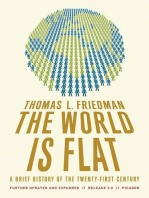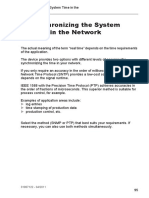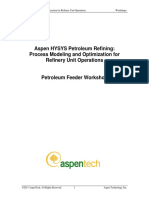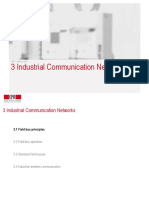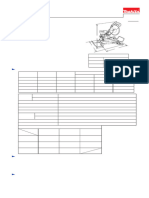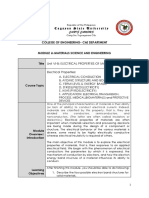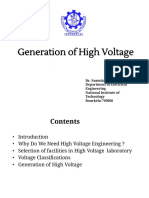NEMA VE 2-2013 Watermarked
NEMA VE 2-2013 Watermarked
Uploaded by
abadnundCopyright:
Available Formats
NEMA VE 2-2013 Watermarked
NEMA VE 2-2013 Watermarked
Uploaded by
abadnundCopyright
Available Formats
Share this document
Did you find this document useful?
Is this content inappropriate?
Copyright:
Available Formats
NEMA VE 2-2013 Watermarked
NEMA VE 2-2013 Watermarked
Uploaded by
abadnundCopyright:
Available Formats
VE 2-2013 Page 35
Figure 3-94 Cable Tray Cover Clamps and Accessories NOTE: Special consideration should be given to wind loading on outdoor applications. Table 3-3 provides information on the required spacing for cover clamps. Table 3-3 Quantity of Standard Cover Clamps Required Straight section, 1.8 m (6 ft) Straight section, 3.0 m (10 ft) and 3.7 m (12 ft) Horizontal/vertical bends Tees Crosses 4 pieces 6 pieces 4 pieces 6 pieces 8 pieces
NOTE: When using the heavy-duty cover clamp shown in Figure 3-94 e, only half the quantity of pieces are required. 3.8 GROUNDING AND BONDING
NEC Article 392.60 requires that metallic cable trays be grounded and electrically continuous. In general, non-current-carrying parts of equipment that are likely to become energized are required to be connected to an equipment grounding conductor (EGC). For further information, see NEC Articles 250.96, 250.110, 250.112, and 250.134. Some manufacturers may recommend bonding and/or grounding of their equipment for other purposes, such as electromagnetic interference (EMI), radio frequency interference (RFI), or electrostatic discharge (ESD). NOTE: For further information, see NEC Articles 250.20(A), 250.112(I), 800.2, 800.50, and 800.100. Cable trays are suitable as EGC's when classified to NEMA VE 1.
Copyright 2013 National Electrical Manufacturers Association
VE 2-2013 Page 36
For specific areas requiring bonding for electrical continuity, refer to Figure 3-95 through Figure 3-98. 3.8.1 Cable Tray Used as an Equipment Ground Conductor (EGC)
For examples, see Figure 3-95 through Figure 3-98. Aluminum and steel cable tray, fittings, and connectors are permitted to be used as an EGC in accordance with NEC Article 392.60 under the conditions specified, if classified and marked with the cross-sectional area. Using Table 3-4, verify that the cross-sectional area of the cable tray, fittings, and connectors are all appropriate for the maximum rating or setting of the overcurrent protection device. If bonding jumpers are used, or if cable tray connectors are not classified as EGCs, NEC Article 250.102 specifies bonding jumper sizes. NOTE: Stainless steel cable trays are not permitted for use as an EGC. Stainless steel cable trays or stainless steel splice connectors require proper bonding, using manufacturer-recommended methods, per NEC Articles 392.60 and 250.96.
Figure 3-95 Expansion Splice Plates
Figure 3-96 Horizontal Adjustable Splice Plates
Figure 3-97 Discontinuous
Figure 3-98 Cable Tray Sections Vertical Adjustable Splice Plate
3.8.2
Cable Trays with Wire-Type Equipment Grounding Conductor (EGC) Installed
For an example, see Figure 3-99. When a wire-type EGC is installed in or on cable tray, it may be bonded to the cable tray with a grounding clamp. Grounding clamp styles include bolted lug types, which require drilling the cable tray side rail, and clamp-on styles that work like a beam clamp. One listed grounding
Copyright 2013 National Electrical Manufacturers Association
VE 2-2013 Page 37 clamp should be used on each section of cable tray. Install a wire-type EGC or bonding jumper at areas where: a) the cable tray is not mechanically continuous, or b) non-classified connectors are installed, or c) gaps surpass the length of traditional bonding jumpers.
Figure 3-99 Grounding Clamps Bare copper wire-type EGC should not be used in or on aluminum cable tray. Bonding jumpers are not required if the wire-type EGC is properly bonded to all equipment. 3.8.3 3.8.3.1 Check for Properly Sized EGC or Bonding Jumpers Power Applications
Bonding jumpers and EGCs are sized according to NEC Articles 250 and 392. NOTE: NEC Table 392.60(A) is the actual circuit breaker trip setting, and not the maximum allowable, under the conditions in NEC Article 240.6. If the maximum ampere rating of the cable tray system is not sufficient for the protective device used, the cable tray system cannot be used as an EGC, and the NEC requires that a wire-type EGC be included in the cable tray system. 3.8.3.2 Non-Power Applications
Cable tray systems containing conductors outside the scope of NEC Article 250 (such as data, communications, signal cables, or others) still require proper bonding and grounding for system operation and performance. Metal trays containing these conductors shall be electrically continuous, via listed connectors or the use of a bonding jumper. Electrical continuity across field-fabricated wire mesh fittings can be accomplished using listed wire mesh tray connectors and following the manufacturers installation instructions. 3.8.3.3 Mixed Systems
When single-conductor power conductors are installed in metallic cable tray systems with non-power conductors, see the bonding and grounding guidance in Section 3.8.3.1. NOTE: Power and non-power cables should be separated with a fixed barrier.
Copyright 2013 National Electrical Manufacturers Association
VE 2-2013 Page 38 Table 3-4 Metal Area Requirements for Cable Tray Systems Used as Equipment Grounding Conductors (NEC Table 392.60(A)) Maximum Fuse Ampere Rating, Circuit Minimum Cross-Sectional Area of Metal* Breaker Ampere Trip Setting, or Circuit Steel Cable Trays Aluminum Cable Trays Breaker Protective Relay Ampere Trip Setting for Ground-Fault Protection of Any 2 2 2 2 mm in mm in Cable Circuit In the Cable Tray System 60 129 0.20 129 0.20 100 258 0.40 129 0.20 200 451.5 0.70 129 0.20 400 645 1.00 258 0.40 600 967.5 1.50** 258 0.40 1000 --387 0.60 1200 --645 1.00 1600 --967.5 1.50 2000 --1290 2.00** * Minimum cross-sectional area of metal (as adapted from NEC Table 392.60(A)): a) both side rails for ladder or trough cable tray systems; or b) in single-rail or channel cable tray systems, or cable tray systems of one-piece construction; or c) longitudinal wires for wire mesh cable tray systems. ** NEC Table 392.60(A) states: Steel cable trays shall not be used as equipment grounding conductors for circuits with ground-fault protection above 600 amperes. Aluminum cable trays shall not be used as equipment grounding conductors for circuits with ground-fault protection above 2000 amperes. NOTE: See Section 4.7.3.1 to select wire-type EGC.
Copyright 2013 National Electrical Manufacturers Association
VE 2-2013 Page 39 Table 3-5 Minimum Size Equipment Grounding Conductors for Grounding Raceway and Equipment (NEC Table 250.122) Rating or Setting of Automatic Overcurrent Device in Circuit Ahead of Equipment, Conduit, etc., Not Exceeding(Amperes) 15 20 60 100 200 300 400 500 600 800 1000 1200 1600 2000 2500 3000 4000 5000 6000 * See installation restrictions in NEC Article 250. 3.8.4 How to Install Bonding Jumpers Wire Size (AWG or kcmil) Aluminum or Copper-Clad Aluminum* 12 AWG 10 8 6 4 2 1 1/0 2/0 3/0 4/0 250 kcmil 350 400 600 600 750 1200 1200
Copper 14 AWG 12 10 8 6 4 3 2 1 1/0 2/0 3/0 4/0 250 kcmil 350 400 500 700 800
For examples, see Figure 3-100. Bonding jumper types include insulated, bare, braided, or laminated.
Figure 3-100 Bonding Jumper Examples Drill holes in each side rail 50 mm (2 in) from each end of the splice plate so the bonding jumper spans the discontinuity. Do not use splice plate bolt locations to connect the bonding jumper to cable tray. Place the screw head on the inside of cable tray. Put the bonding jumper on the outside of the cable tray, add a flat washer and locknut, and then tighten. 3.9 BONDING TO THE METAL FRAME OF THE BUILDING AND EARTH
Metallic cable trays are permitted to be bonded to the metal frame of the building and earth for signal grounding (noise prevention). This may be desirable if the cable tray system is not inherently bonded (connected) to the metal frame of the building and earth through metallic support systems.
Copyright 2013 National Electrical Manufacturers Association
You might also like
- The Subtle Art of Not Giving a F*ck: A Counterintuitive Approach to Living a Good LifeFrom EverandThe Subtle Art of Not Giving a F*ck: A Counterintuitive Approach to Living a Good LifeRating: 4 out of 5 stars4/5 (5987)
- The Gifts of Imperfection: Let Go of Who You Think You're Supposed to Be and Embrace Who You AreFrom EverandThe Gifts of Imperfection: Let Go of Who You Think You're Supposed to Be and Embrace Who You AreRating: 4 out of 5 stars4/5 (1112)
- Never Split the Difference: Negotiating As If Your Life Depended On ItFrom EverandNever Split the Difference: Negotiating As If Your Life Depended On ItRating: 4.5 out of 5 stars4.5/5 (898)
- Hidden Figures: The American Dream and the Untold Story of the Black Women Mathematicians Who Helped Win the Space RaceFrom EverandHidden Figures: The American Dream and the Untold Story of the Black Women Mathematicians Who Helped Win the Space RaceRating: 4 out of 5 stars4/5 (932)
- Grit: The Power of Passion and PerseveranceFrom EverandGrit: The Power of Passion and PerseveranceRating: 4 out of 5 stars4/5 (619)
- Shoe Dog: A Memoir by the Creator of NikeFrom EverandShoe Dog: A Memoir by the Creator of NikeRating: 4.5 out of 5 stars4.5/5 (546)
- The Hard Thing About Hard Things: Building a Business When There Are No Easy AnswersFrom EverandThe Hard Thing About Hard Things: Building a Business When There Are No Easy AnswersRating: 4.5 out of 5 stars4.5/5 (357)
- Her Body and Other Parties: StoriesFrom EverandHer Body and Other Parties: StoriesRating: 4 out of 5 stars4/5 (831)
- Elon Musk: Tesla, SpaceX, and the Quest for a Fantastic FutureFrom EverandElon Musk: Tesla, SpaceX, and the Quest for a Fantastic FutureRating: 4.5 out of 5 stars4.5/5 (477)
- The Emperor of All Maladies: A Biography of CancerFrom EverandThe Emperor of All Maladies: A Biography of CancerRating: 4.5 out of 5 stars4.5/5 (275)
- The Little Book of Hygge: Danish Secrets to Happy LivingFrom EverandThe Little Book of Hygge: Danish Secrets to Happy LivingRating: 3.5 out of 5 stars3.5/5 (425)
- The World Is Flat 3.0: A Brief History of the Twenty-first CenturyFrom EverandThe World Is Flat 3.0: A Brief History of the Twenty-first CenturyRating: 3.5 out of 5 stars3.5/5 (2272)
- The Yellow House: A Memoir (2019 National Book Award Winner)From EverandThe Yellow House: A Memoir (2019 National Book Award Winner)Rating: 4 out of 5 stars4/5 (99)
- The Sympathizer: A Novel (Pulitzer Prize for Fiction)From EverandThe Sympathizer: A Novel (Pulitzer Prize for Fiction)Rating: 4.5 out of 5 stars4.5/5 (125)
- Devil in the Grove: Thurgood Marshall, the Groveland Boys, and the Dawn of a New AmericaFrom EverandDevil in the Grove: Thurgood Marshall, the Groveland Boys, and the Dawn of a New AmericaRating: 4.5 out of 5 stars4.5/5 (270)
- A Heartbreaking Work Of Staggering Genius: A Memoir Based on a True StoryFrom EverandA Heartbreaking Work Of Staggering Genius: A Memoir Based on a True StoryRating: 3.5 out of 5 stars3.5/5 (232)
- Team of Rivals: The Political Genius of Abraham LincolnFrom EverandTeam of Rivals: The Political Genius of Abraham LincolnRating: 4.5 out of 5 stars4.5/5 (235)
- Electrical Schematic With EMCP IIDocument4 pagesElectrical Schematic With EMCP IIAnonymous uEt1sNhU7l89% (19)
- On Fire: The (Burning) Case for a Green New DealFrom EverandOn Fire: The (Burning) Case for a Green New DealRating: 4 out of 5 stars4/5 (75)
- The Unwinding: An Inner History of the New AmericaFrom EverandThe Unwinding: An Inner History of the New AmericaRating: 4 out of 5 stars4/5 (45)
- Slidex - Tips - 7 Synchronizing The System Time in The Network PDFDocument12 pagesSlidex - Tips - 7 Synchronizing The System Time in The Network PDFabadnundNo ratings yet
- Guia de Logicas Inputs y Outputs 1Document53 pagesGuia de Logicas Inputs y Outputs 1abadnundNo ratings yet
- CORLITDocument140 pagesCORLITabadnundNo ratings yet
- TCG 02 e Rev13 PDFDocument63 pagesTCG 02 e Rev13 PDFabadnundNo ratings yet
- EWS 004 HYSYS Refining Part 3 - PetroleumFeederDocument9 pagesEWS 004 HYSYS Refining Part 3 - PetroleumFeederabadnundNo ratings yet
- InRouter611-S Specification v1.3 Sep.2017Document7 pagesInRouter611-S Specification v1.3 Sep.2017abadnundNo ratings yet
- Industrial Communication NetworksDocument87 pagesIndustrial Communication NetworksabadnundNo ratings yet
- Ee 11Document17 pagesEe 11Juphil PletoNo ratings yet
- Final Report OrganizedDocument39 pagesFinal Report OrganizedMASARATH BEGUMNo ratings yet
- Module 6 Measuring InstrumetsDocument15 pagesModule 6 Measuring Instrumetsstefanpc117No ratings yet
- Comparing Slip Ring Motors With Standard Ac MotorsDocument4 pagesComparing Slip Ring Motors With Standard Ac MotorsFrançois SteinmetzNo ratings yet
- AstronomyDocument38 pagesAstronomyArindam Bandyopadhyay100% (1)
- An Invitation To Graphical Tensor MethodsDocument30 pagesAn Invitation To Graphical Tensor MethodsHIPOLITO ARTURO RIVEROS GUEVARANo ratings yet
- Non - Destructive TestingDocument28 pagesNon - Destructive TestingPhilip PanaNo ratings yet
- ATV28 User ManualDocument100 pagesATV28 User ManualIgnacio AlonsoNo ratings yet
- AP Government GATE Online Classes: Heat TransferDocument71 pagesAP Government GATE Online Classes: Heat TransferRajmangal Nishad100% (1)
- Makita Ls1013-Te Service ManualDocument12 pagesMakita Ls1013-Te Service Manual2dcopasNo ratings yet
- Chapter 3Document9 pagesChapter 3Hamza HussineNo ratings yet
- Module in Electrical Properties of MaterialsDocument22 pagesModule in Electrical Properties of MaterialsFrendick LegaspiNo ratings yet
- Written Output For 3 Quarter Performance TaskDocument4 pagesWritten Output For 3 Quarter Performance TaskCarl SolivaNo ratings yet
- IEC 61439 - Low Voltage Switchgear & Control Gear AssembliesDocument5 pagesIEC 61439 - Low Voltage Switchgear & Control Gear Assembliesamit.gargNo ratings yet
- CBSE Class 10 Science Revision Notes Chapter 12 Electricity: Charge (Q)Document5 pagesCBSE Class 10 Science Revision Notes Chapter 12 Electricity: Charge (Q)Suman KumarNo ratings yet
- Induction MotorDocument12 pagesInduction MotorsacchashuddhoNo ratings yet
- 1ST Periodical Test in Science 8Document3 pages1ST Periodical Test in Science 8merlindaNo ratings yet
- Nuclear Medicine and Molecular Imaging The Requisites 5Th Edition Janis P Omalley Full Chapter PDFDocument69 pagesNuclear Medicine and Molecular Imaging The Requisites 5Th Edition Janis P Omalley Full Chapter PDFremarktrippl5100% (17)
- EC 6702-2 Marks QP With Answer, 16 MarkDocument19 pagesEC 6702-2 Marks QP With Answer, 16 MarkSathya PriyaNo ratings yet
- 1950 Frequency Meter Urm80 PDFDocument131 pages1950 Frequency Meter Urm80 PDFPeterNo ratings yet
- Microwave Radio Propagation: Technical Center Group NEC IndiaDocument17 pagesMicrowave Radio Propagation: Technical Center Group NEC IndiaSrikanth MahadevuniNo ratings yet
- Basics of Substation Protection: Said Salim Palayi Assistant Executive Engineer, 220 KV Substation, AreekodeDocument70 pagesBasics of Substation Protection: Said Salim Palayi Assistant Executive Engineer, 220 KV Substation, Areekodeewnetu kassaNo ratings yet
- Free Vibration of SDOFDocument11 pagesFree Vibration of SDOFreneil llegueNo ratings yet
- Physical Science (Module 15)Document24 pagesPhysical Science (Module 15)Zen Pasumbal83% (6)
- Antenna and Wave PropagationDocument3 pagesAntenna and Wave PropagationRatsihNo ratings yet
- Hydroponic LightingDocument8 pagesHydroponic LightingMallikarjun RaoNo ratings yet
- Special WPT AssignmentDocument18 pagesSpecial WPT AssignmentMithun Dev NathNo ratings yet
- Modelling A Linear and Limited Travel SolenoidDocument6 pagesModelling A Linear and Limited Travel SolenoidAditya KashyapNo ratings yet
- Generation High Voltage1Document54 pagesGeneration High Voltage1Abhishek SahooNo ratings yet




















